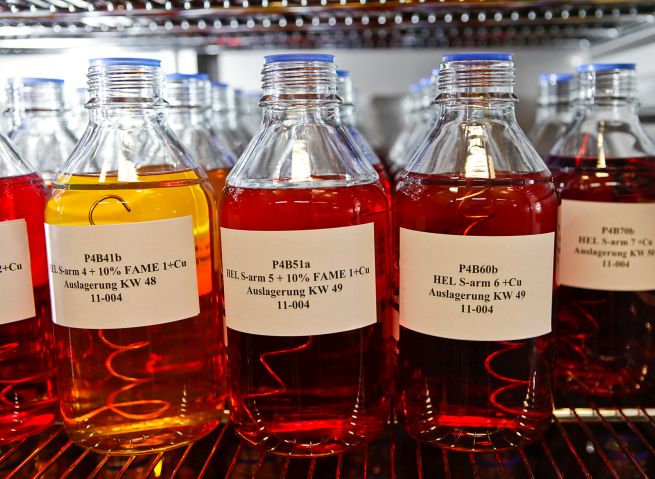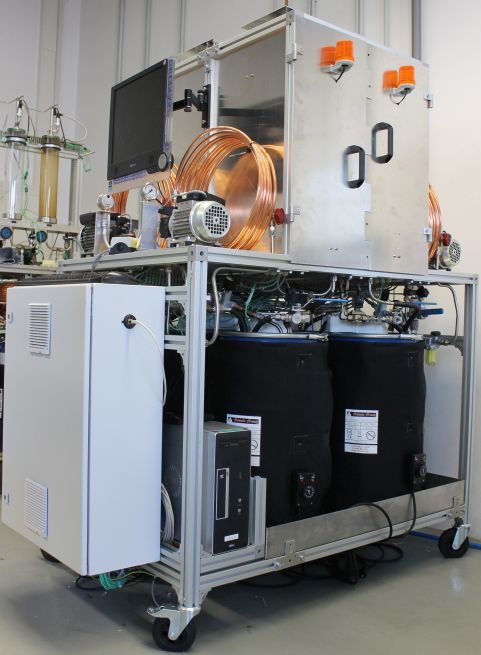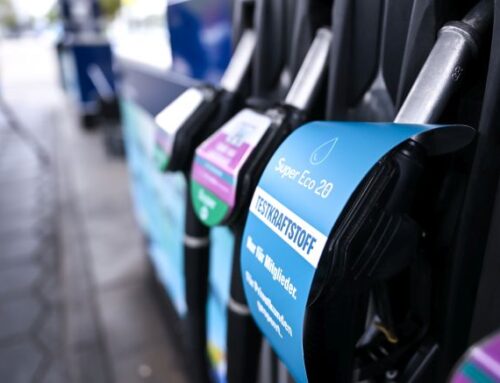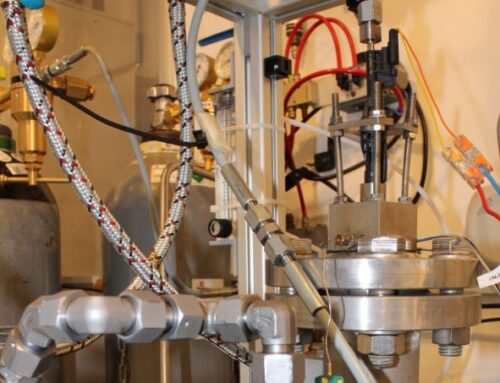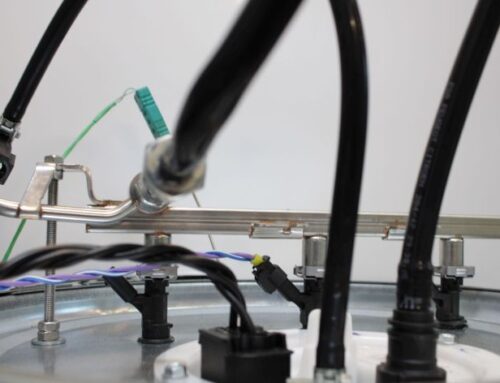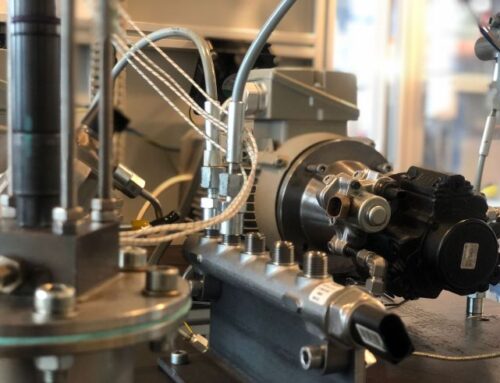High requirements for synthetic and biogenic fuels
02 February 2021 – New synthetic and biogenic fuels have the potential to replace petroleum-based gasoline and diesel as well as heating oil and to make mobility and heat generation more climate-friendly in the future. In Part 2 of our short series of articles, we explained they must be operationally safe, i.e. drop-in capable, and compatible with technical components and materials. Simon Eiden explained which requirements have to be met and which test methods Tec4Fuels is using to investigate the future behavior of fuels and components and validate their operationally safe use in a presentation at the Eurofuel-NORA web conference in fall 2020.
With petroleum-based fuels, consumers are used to comfort, safety, engine durability, and affordable price levels. This is also expected as a matter of course from new synthetic fuels. But the requirements for the new biogenic and synthetic fuels, some of which are still being researched, are much higher and pose new challenges for fuel manufacturers, engine developers and heating system manufacturers. The question of suitable raw materials and their availability for the medium- and long-term production of large and sufficient quantities of fuel with a secure supply already arises in advance. Closely linked to the selection of raw materials is the question of the sustainability of biogenic and synthetic fuels. The European Union’s Renewable Energy Directive 2 (RED II) stipulates that the greenhouse gas savings potential must be greater than 70% compared with petroleum-based fuels. In addition, RED II stipulates that competing uses with the production of food and animal feed must be avoided. From the perspective of the petroleum industry, the investment costs for setting up industrial production facilities, ongoing operating costs and raw material costs must be estimated at an early stage.
High requirements for synthetic fuels and combustibles
High requirements for synthetic fuels and combustibles
Last but not least, the requirements of the respective technical applications must also be taken into account.
- The fuels must be safe to handle and usable within the existing logistics and service station infrastructure.
- They must be backward compatible, i.e., also compatible with older technical systems (engines, heaters, etc.).
- They must have “drop-in quality,” i.e., be easily miscible with conventional fuels and have the potential to improve fuel quality
- and, last but not least, be accepted by customers.
When new climate-friendly liquid fuels are blended with gasoline and diesel in the future, their composition will change. The purely analytical laboratory test methods prescribed in the standards are not always capable of reliably identifying combinations of cross-reactions of fuel constituents and additives under the conditions of use in modern application technology.
As a result, the mineral oil industry and vehicle manufacturers are faced with new requirements for the quality assurance of fuels. For a fuel to be “fit for purpose,” it must be extensively tested before it is launched on the market. This includes, for example, checking
- possible interactions between the materials of fuel-carrying components and the fuels, and
- between biogenic or synthetic and conventional fuels in different blending proportions
- and combustion behavior.
- In addition, there are long-term tests of fuels under laboratory conditions and
- field tests and tests of closed vehicle fleets in model regions.
Tec4Fuels has developed special test methods that can be used to validate new fuels quickly and reliably.
Static test procedures for quality assurance of fuels
In principle, all alternative fuels placed on the market with admixtures of biogenic or synthetic components that can replace petroleum-based fuels must comply with the respective standards. Examples include bioheating oil (containing up to 10% fatty acid methyl ester, FAME) in the space heating market, superfuel E10 (containing up to 10% ethanol) and diesel fuel (containing up to 7% fatty acid methyl ester, FAME). The aim is to ensure that their quality on delivery is sufficiently high to guarantee the operational reliability of components in technical systems such as engines or heating appliances. A statement about the storage stability of the fuels cannot be made on the basis of the tests of the requirements according to the standards. Depending on their composition, fuels age at different rates and also behave differently during aging. In aging tests, various fuel samples are stored at Tec4Fuels under defined conditions that approximate the loads in real applications. To test their long-term stability, the samples are tested over varying periods of time and temperature levels. Depending on the test design, the duration of storage can range from 1 to 24 months and temperatures can vary between 8° and 80 °C. In general, the tests show that the addition of FAME as an alternative component to diesel fuel or heating oil without stabilization measures can intensify possible aging reactions. As a result, the oxidation stability of the fuel decreases and sediments form during storage. However, suitable additivation of the fuel mixture with antioxidants significantly delays aging reactions.
BigOxy: Testing the storage stability of fuels more quickly
The BigOxy test method is suitable for making an initial and rapid statement about the long-term storage stability of a fuel. This is a forced aging test that “stresses” the fuel under variable conditions in such a way that the autoxidation reaction is forced. This rapid aging reaction occurs at pressures between 1.2 and 5 bar and temperatures of up to 250 °C. As a rule, the tests are designed to last 64 or 128 hours, depending on requirements. The BigOxy test method is suitable for both heating oil and diesel fuel as well as gasoline, also with different blends of alternative fuels and additives.
Dynamic test procedures for application-oriented tests
Comparatively long periods of time and large quantities of fuel are required for the investigation of fuel-hardware interaction in engine or heating tests – this entails high costs. Chemical fuel analyses show the actual state of the fuel, but cannot represent all aspects of the fuel-component interaction. To investigate an appropriate matrix of novel fuels and their blends, Tec4Fuels has developed a test method that can test a larger number of fuels at low cost with a small sample size in the shortest possible time.
Using HiL tests to detect interactions
The “hardware-in-the-loop” (HiL) testing principle used by Tec4Fuels for various applications offers a solution here. The fuel is conveyed through all the fuel-carrying components to be tested, as in the real system, but is not burned. It is collected again and circulated through the components. This keeps the required fuel volume low and accelerates aging.
This is a major advantage, especially for fuels under development, since only small quantities are available in the early stages. Especially in the area of fuel/system interaction in modern diesel passenger cars, HiL testing is superior to engine testing in terms of cost, flexibility and fuel requirements. The design of the HiL test bench can be built to include the entire system of fuel-carrying components from tank to intank pump, filter, high-pressure pump, rail and injector. Tec4Fuels has also built this principle with the technical components of heating systems, such as filter, pump, preheater and nozzle, in one test rig. This makes it possible to test different fuels as well as technical components. With periodic chemical analyses, aging effects of fuels can be determined in the course of the HiL test. The effectiveness of additives can also be determined in this way. In addition, visual inspections of technical components provide information about possible interactions with fuels.
Examples are
- theHiL-pump test
- the quick test for diesel injectors
- the heating oil performance test
In brief:
Conventional test procedures are either time-consuming and expensive or they only allow statements about the current condition of a fuel. With its application-oriented test methods, Tec4Fuels GmbH can make valid statements about the future behavior of fuels. The methods are comparatively fast and inexpensive. They give manufacturers the certainty that they are entering fleet or field tests or the market with operationally reliable products.
Watch the presentation by Simon Eiden, Tec4Fuels, on application-oriented test methods on youtube.
Our article series:
